Forestry: Strategy Report
Summary
Giving Green investigated interventions that add more trees or prevent tree loss. We evaluated interventions based on their importance (mitigation potential), tractability (likelihood of progress), and neglectedness (need for additional funding).
Many forestry interventions are important, but tractability and neglectedness can be limited. For example, interventions that stop deforestation in one area may shift tree loss elsewhere. Also, forestry projects are generally relatively well-funded. For instance, various foundations have committed $5B to protect and conserve 30 percent of Earth, including forests (Wildlife Conservation Society, 2021). Therefore, we do not believe most forestry projects offer philanthropists the greatest value for money.
However, reducing livestock demand may be promising for preventing deforestation because demand for agricultural land is a significant driver of deforestation. In particular, significant amounts of forestland are cleared to make way for beef, palm oil, and soy production. In our 2022 food sector investigation, we found that supporting alternative proteins may be the most cost-effective way for donors to help reduce meat consumption. Tying this with our deforestation research, we believe replacing some meat consumption with alternative proteins (e.g., plant-based burgers) may be a cost-effective way to prevent forest destruction. However, alternative proteins have not yet dented beef consumption, and there is limited evidence for how they may scale in the future as they improve in price, taste, and convenience. Therefore, we will continue to evaluate alternative protein funding opportunities as this field develops.
In 2022, we investigated organizations promoting alternative proteins, including the Good Food Institute, New Harvest, and the Plant Based Foods Institute. We wrote shallow dive reports on New Harvest and the Plant Based Foods Institute. We wrote a deep dive report on the Good Food Institute and classified it as one of our top recommendations to reduce climate change.We also refreshed our forest carbon offsets report since many forestry projects finance themselves through offsets, which are in high demand. We believe there is value in directing businesses towards forestry offsets that are high-quality and cost-effective.
How do forests impact climate change?
Forests can either be sinks or sources of carbon dioxide (CO2), depending on their balance of carbon inputs and outputs.1 Overall, forests can help mitigate climate change by removing CO2 from the atmosphere. Preventing deforestation also helps avoid carbon emissions.
In some cases, forests can cause warming by reducing the Earth’s reflectivity (albedo) and making the Earth absorb more sunlight. This effect is most pronounced at higher latitudes and in mountainous or dry regions where slow-growing trees with dark leaves absorb more sunlight than light-colored ground or snow (Popkin, 2019). This effect is of much less concern in tropical forests.
1 In addition to absorbing and releasing CO2, trees release various other gases and chemicals that impact heating and cooling in complex ways (e.g., water vapor, isoprene, methane). Research into the different chemicals and gases that trees release and their impact on climate is an emerging area.
What is driving tree loss?
Almost a quarter of global tree loss is due to permanent deforestation, while the remainder comes from temporary forest degradation (e.g., logging, wildfires). The agricultural sector is strongly associated with deforestation. As of 2018, humans have destroyed about one-third of the world’s forests by converting them into land for crops and grazing (FAO, 2020; Ritchie & Roser, 2021a; Williams, 2006). Urban and built-up land played a much smaller role in deforestation. Between 2005 to 2013, 70 to 80 percent of tropical and subtropical deforestation was due to clearing land for either agriculture or tree plantations (Pendrill et al., 2019; Ritchie & Roser, 2021a) (Figure 1). Beef production was responsible for 41 percent of global deforestation. Soybean and palm oil were responsible for almost one-fifth of deforestation. Patterns of tropical deforestation have primarily remained the same after 2013. We expect that agriculture will continue to drive deforestation in the future, especially as the global population increases and countries become wealthier.
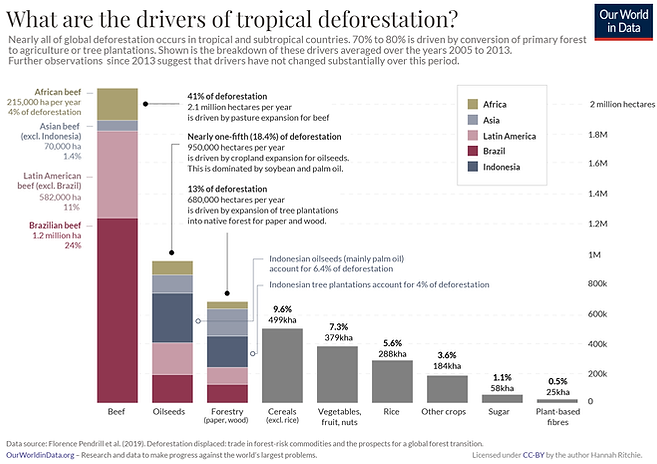
About 95 percent of deforestation occurs in the tropics, while the remaining 5 percent occurs in temperate regions (Ritchie & Roser, 2021b). Countries losing substantial forest areas include Brazil, Indonesia, Tanzania, and Myanmar.
How do we fight tree loss?
Overview
The Intergovernmental Panel on Climate Change’s (IPCC) Working Group III report on climate change mitigation included the following major categories for fighting tree loss (Nabuurs et al., 2022):
- Reduce deforestation and degradation
- Afforestation, reforestation, and forest ecosystem restoration
- Improved forest management (IFM) by timber companies
- Fire prevention
- Agroforestry
Reduce deforestation and degradation
Interventions that curb deforestation and degradation can be direct or enabling activities (Figure 2). Direct activities include establishing and managing conserved areas and decreasing the economic benefits of clearing land. Enabling activities increase the likelihood that direct activities will succeed.
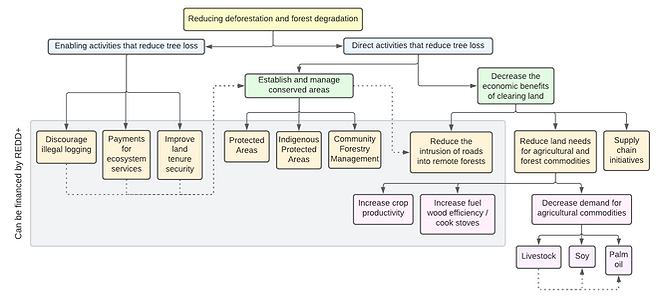
Direct activities that reduce tree loss include establishing and managing conserved areas (e.g., Protected Areas, Indigenous Protected Areas, Community Forestry Management) and decreasing the economic benefits of clearing land (e.g., reducing land-use change related to agricultural commodities). Enabling activities include discouraging illegal logging, Payments for Ecosystem Services (PES), and improved land tenure security.
Afforestation, reforestation, and forest ecosystem restoration
Tree planting is a form of natural carbon removal. People can plant new trees in previously forested (reforestation) or never forested (afforestation) areas (Figure 3). People can also restore degraded forests by planting trees and/or improving soils (forest ecosystem restoration). Improving trees’ carbon removal efficiency helps enable tree planting programs.
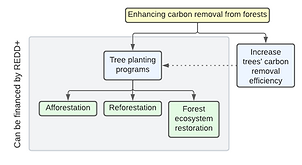
Improved forest management
IFM refers to forestry practices that increase carbon stocks or reduce GHG emissions relative to business-as-usual forestry practices. Major IFM categories include reducing environmental impacts from harvesting timber, protecting conservation zones, and ensuring the growth and regeneration of trees (Griscom & Cortez, 2013) (Figure 4).

Fire management
Fire management includes fuel management, wildfire management, and wildfire prevention (Figure 5). Fuel management (e.g., controlled burns) reduces the risk of catastrophic wildfires that would destroy more vegetation.
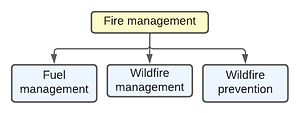
Agroforestry
Agroforestry integrates trees and shrubberies into land intended for crops and livestock. This practice can increase the amount of carbon stored in trees and the soil.
What interventions did Giving Green find most promising?
Giving Green’s criteria
Our goal is to select the most promising interventions based on importance, tractability, and neglectedness, which we define as follows:
- Importance – How much GHG emissions can the intervention avoid or remove from the atmosphere (in expectation).
- Tractability – How likely each intervention is to succeed in avoiding or removing GHGs from the atmosphere.
- Neglectedness – Whether the intervention area has room for more funding.
Assessing the importance of intervention areas
We found that the primary intervention areas for decreasing forestry-related emissions have varying levels of effectiveness. The IPCC reported the following technical and economic GHG mitigation potentials between 2020 and 2050 (Nabuurs et al., 2022) (Figure 6).2,3,4

IFM and fire management are less important than the other forestry intervention areas. Although agroforestry’s technical mitigation potential was on par with reducing deforestation and degradation and afforestation/reforestation, its economic mitigation potential is relatively low. It is conceivable that agroforestry could become more cost-effective in the future, but we do not expect it to become cheap very quickly. Ultimately, the most important intervention areas appear to be reducing deforestation and degradation and afforestation/reforestation.
Assessing tractability and neglectedness
We deprioritized many forestry interventions because they fell short in tractability and/or neglectedness. Because the tractability and neglectedness of the various solutions were difficult to quantify, we categorized how well the interventions met these metrics as “High,” “Medium,” and “Low” (Table 1). We describe these ratings and summarize our findings in Table 2. For more information on how we rated these various forestry interventions on tractability and neglectedness, please see Appendices A-E.
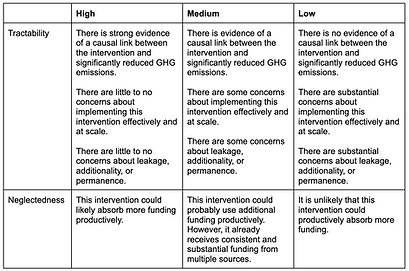
Reduced meat consumption can address the drivers of deforestation.
Overall, Giving Green believes that interventions focused on reducing meat consumption are likely the most promising current avenue for philanthropists to limit deforestation. For example, reducing beef consumption could play a key role in reducing deforestation because beef production is a major driver of tree loss. Decreasing consumption of other meats, such as chicken and pork, would also slow down deforestation because palm oil and soy are common ingredients in their feed. We were especially keen on reduced meat consumption because, unlike many other interventions we investigated, it addresses the root causes of deforestation. Crucially, interventions that do not address the root causes of deforestation always run the risk of displacing deforestation, which is challenging to measure and impacts tractability.
Based on our prior investigation into food sector emissions, we believe that promoting alternative proteins may be the most promising method for reducing meat consumption. Under this theory of change, alternative proteins could displace some of the demand for conventional meats if they became competitive with conventional meats. Currently, alternative protein as a climate change mitigation strategy is highly speculative, and more research is needed. Additionally, reducing meat consumption may not impact deforestation in Sub-saharan Africa, where much of the region’s tree loss is due to subsistence farming, not beef, palm oil, and soy exports. We do not currently plan to investigate this area further but may update our broader views in the future based on new evidence and changing funding landscapes.
2 Technical mitigation potential refers to the amount of CO2-equivalent that can be mitigated based on current technology. It seems unlikely that technological progress between 2020 and 2050 will drastically change most interventions’ technical mitigation potentials.
3 Economic mitigation potential is the amount that can be mitigated based on current technology at a maximum cost of $100 ton per CO2-equivalent.
4 The IPCC’s Agriculture, Forestry, and Other land-use solutions have an extensive range of potential mitigation values because “current carbon stocks and fluxes are unclear and subject to temporal variability” (Nabuurs et al., 2022).
What is Giving Green doing next?
After we selected alternative proteins as our most promising intervention for philanthropists to limit deforestation, we investigated organizations that advocate for alternative proteins. We conducted shallow dive investigations into New Harvest and the Plant Based Foods Institute and a deep dive investigation into the Good Food Institute (GFI). In 2022, we recommended GFI based on its accomplishments, organizational strengths, strategic approach, and cost-effectiveness. We believe GFI has substantial room to grow in its three programmatic areas (scientific research, policy advocacy, and corporate engagement) and across its various offices, and that it will increase the likelihood of alternative proteins going mainstream. Since alternative protein production is still in its early stages, we plan to continue to monitor its climate impact and look forward to following GFI’s efforts in this space.
In 2022, we also refreshed our forestry offsets report because of the high demand for this offset. Although many forestry offsets face issues with additionality, permanence, and leakage, there is such a broad diversity of forestry offsets that we believe some high-quality and innovative offsets may be impactful. Directing donors who want to purchase forestry offsets towards these high-quality offsets could reduce the amount of money spent on low-quality forestry offsets. However, we generally recommend donating to policy organizations over purchasing carbon offsets because policy tends to be more cost-effective in expectation.
Appendix A: Interventions focused on reducing deforestation and degradation
A.1 Protected Areas
A.1.1 Background
Preserving forests as Protected Areas (PAs) is a common policy instrument. PAs have land-use restrictions that prevent or limit extractive activities on their land. PAs vary in size and degree of protection. PAs include national parks, wildlife sanctuaries, nature reserves, and buffer areas alongside roads. Some PAs allow for some extraction, while others solely focus on conservation.
A.1.2 Tractability
According to a meta-analysis of deforestation drivers, PAs were consistently associated with less deforestation (Busch & Ferretti-Gallon, 2017). However, PAs are disproportionately sited on land with characteristics that inhibit land-use change (e.g., slope, elevation, remoteness) (Joppa & Pfaff, 2009; Venter et al., 2018). As a result, these sites are less likely to experience deforestation in the first place, and protecting them may not satisfy additionality. Additionally, PAs are not necessarily permanent; people may downgrade, downsize, and degazette them over time (Mascia & Pailler, 2011). This impermanence is associated with social pressures to access and use PAs’ natural resources. One study found that across almost 2,000 PAs, PAs lost forested land at an average rate of 0.18 percent per year. PAs with lower protection status lost forested land at the highest rate (0.39 percent per year) (Collins & Mitchard, 2017).
PAs can have spillover effects on surrounding areas. For example, protecting one place from deforestation could lead to forest clearing in another location (leakage). PAs can also prevent deforestation in another place by discouraging road development and industry investments (blockage). According to one study, 11.8 percent of the PAs that reduced deforestation within their boundaries led to leakage, while 54.8 percent led to blockage (Fuller et al., 2019).
A.1.3 Neglectedness
Nine grantmakers pledged in September 2021 to donate $5B between 2021 and 2031 to efforts focused on conserving at least 30 percent of Earth (Wildlife Conservation Society, 2021). Since large funders have already committed to spending so much on conservation, it seems unlikely that other donors would have as much additional impact if they donated to this space.
A.2 Indigenous Protected Areas
A.2.1 Tractability
Some studies have found less deforestation occurs on Indigenous lands (ILs) compared to non-protected areas and that in some regions, ILs outperform traditional PAs in preventing deforestation (Sze et al., 2022). Indeed, a deforestation meta-analysis found that the presence of Indigenous peoples was associated with lower deforestation rates (Busch & Ferretti-Gallon, 2017). The correlation between the presence of Indigenous peoples and lower deforestation rates can be explained to some degree by limited resources and lack of market access. However, even when researchers accounted for these differences, ethnicity was still a significant factor across several studies (FAO & FILAC, 2021). One explanation is that traditional knowledge of the environment and its response to human practices could encourage more sustainable practices (Sze et al., 2022).
There are numerous challenges to securing land tenure for Indigenous peoples. For example, strengthening territorial rights is expensive, complex, and lengthy. Additionally, some countries do not recognize Indigenous or tribal communities as legal entities (FAO & FILAC, 2021). Furthermore, government recognition of territorial rights to the land may not reduce deforestation. For example, forest users may be interested in clearing the land anyway, and IPAs face challenges related to permanence, additionality, and leakage similar to PAs’.
A.2.2 Neglectedness
We believe that IPAs are not especially neglected. For example, a coalition of governments and private funders have pledged $1.7B to help Indigenous and local communities protect tropical forests (Beasley, 2021). Additionally, this intervention area receives funding from groups not solely focused on climate, including traditional environmental organizations and groups focused on human rights.
A.3 Community Forestry Management
A.3.1 Tractability
Early research into CFM did not show strong evidence for effectiveness because the studies were not rigorously designed (Bowler et al., 2012). In general, evaluating the efficacy of CFM has been challenging because there are significant differences in how people implement CFM. For example, there have been instances where CFM only exists on paper (Lund et al., 2009).
Later research into CFM has not suggested a substantial impact on deforestation. For example, a meta-analysis on the drivers of deforestation found that CFM was not consistently associated with either higher or lower levels of deforestation (Busch & Ferretti-Gallon, 2017). In some cases, CFM reduced deforestation by providing better governance, while in other instances, CFM increased deforestation by encouraging agricultural conversion (Barsimantov & Kendall, 2012). In addition, a study published in 2015 found no difference in deforestation between CFM and non-CFM areas, although CFM areas that included PES had some minor success (Rasolofoson et al., 2015).
A.3.2 Neglectedness
It is unclear how much people spend on CFM and how much room for more funding this intervention has. However, it is likely that CFM already receives substantial financing from governments and agencies focused on global development. For example, the World Bank has worked on projects that shift land tenure towards community-based management (The World Bank, 2016).
Rainforest Alliance is a major organization working on CFM. Its annual revenue in 2020 was about $52M, but it did not spend all of this on CFM (Rainforest Alliance Inc., 2021).
A.4 Reduce the intrusion of roads into remote forests
A.4.1 Tractability
Reducing the intrusion of road projects into remote forests is challenging because it often means pushing back against companies with a vested interest in increasing road networks. Therefore, efforts that target roads with low economic benefits are probably more tractable. Leakage presents another tractability concern.
A.4.2 Neglectedness
Reducing road development into forests has attracted the interest of some major funders. For example, the Gordon and Betty Moore Foundation has previously supported work along the BR-319 Highway in the Brazilian Amazon. Its most recent grant was a roughly $1M grant to Fundação Getúlio Vargas, a Brazilian higher education institution and think tank, in August 2021 (Gordon and Betty Moore Foundation, 2021).
It is challenging to quantify this intervention’s room for more funding because it overlaps with other interventions. For example, efforts to conserve forests also tackle reduced road development because people cannot build major road systems in protected areas.
A.5 Increase crop productivity
A.5.1 Tractability
Increased farm productivity can have mixed effects on deforestation. For example, market-driven intensification often leads to cropland expansion because farmers are incentivized to grow and sell even more crops, clearing trees in the process. In contrast, technology-driven intensification often leads to a global net saving of land, although deforestation may continue to occur in specific areas (Byerlee et al., 2014). In general, the direction and magnitude of land-use change are context-specific and depend on land and forest governance and labor markets. Additionally, increased farm productivity is logistically challenging because it requires building local capacity and developing new infrastructure.
A.5.2 Neglectedness
Increasing farm productivity is complex and receives funding from organizations working on other cause areas, such as international development. Funders include government agencies, bilateral and multilateral institutions, and private foundations. For example, BMGF gave $398M in 2021 to efforts that support agricultural development (Bill & Melinda Gates Foundation, 2021).5 Additionally, many of the countries that spend the greatest proportion of their government expenditures on agriculture are low-income countries that are presumably working on improving farm productivity (FAO, 2021).6 Overall, it seems likely that increasing farm productivity is not especially neglected.
A.6 Increase fuelwood efficiency/cookstoves
A.6.1 Tractability
Efficient cookstoves are meant to decrease the amount of wood fuel households use. However, they do not necessarily lead to reductions due to variations in human behavior. Overall, rigorous impact assessments of fuel-efficient cookstoves and their effect on fuel usage have mixed results. We describe a few studies below:
- Bensch and Peters (2015) – Improved cookstoves in Senegal led to large decreases in firewood usage. However, 27% of meals were still cooked on traditional stoves in the treatment group a year after distribution.
- Berkouwer and Dean (2019) – Improved cookstoves in Kenya reduced fuel expenditure by 40% and effects persisted for 18 months after the cookstoves’ adoption.
- Hanna et al. (2016) – There was no change in GHG emissions from a cookstove project in India, primarily due to the disadoption of stoves.
- Aung et al. (2013) – There was no change in fuel usage for a cookstove project that received emissions credits in India.
- Beltrama and Levine (2013) – There was no effect of an improved cookstove on fuel usage in Senegal.
Overall, we cannot confidently recommend cookstove projects unless causality has been validated with a high-impact evaluation.
A.6.2 Neglectedness
Clean cookstoves may not be especially neglected as a policy solution. For example, between 2017 and 2019, clean cookstove companies received an estimated $26M in grants and $127M in capital (Ferguson et al., 2021). For more information, please see our Fuel-Efficient Cookstoves report.
A.7 Decrease demand for agricultural commodities
Beef, soy, palm oil, paper, and pulp are the leading agricultural commodities behind deforestation (Pendrill et al., 2019; Ritchie & Roser, 2021a). We focused our investigation on beef and palm oil because they cause more extensive deforestation than soy, paper, and pulp.
A.7.1 Livestock
A.7.1.1 Tractability
Curbing demand for animal products could reduce the amount of land that people clear to meet livestock needs and decrease direct emissions from ruminants. Interventions for reducing meat consumption include the following:
- Implementing large-scale programs that reduce meat consumption (e.g., Meatless Mondays)
- Educating people on the consequences of eating meat
- Increasing the cost of meat, such as by taxing meat
- Making alternative proteins competitive with conventional meat
According to our research on food sector emissions, these interventions vary in tractability and neglectedness. In general, we were keen on interventions encouraging consumers to eat less meat in invisible ways, such as through nudges and making alternative proteins competitive with conventional proteins. However, we did not find nonprofit organizations that implement nudges well at scale, which hampers that intervention’s tractability. Based on our analysis of alternative proteins, it is plausible that improving and promoting alternative proteins could displace demand for conventional meat. However, there is limited evidence for its ability to reduce emissions, and there are open questions, such as what foods people would substitute with alternative proteins. Therefore, alternative proteins as a lever for reducing emissions is speculative and requires more research.
A.7.1.2 Neglectedness
An analysis by Vivid Economics stated that public funding for alternative proteins RD&D and commercialization should reach $4.4B and $5.7B per year to unlock their full socioeconomic and environmental benefits (Vivid Economics, 2021). Nonprofits that advocate for increased RD&D include the Good Food Institute and New Harvest; the Plant Based Foods Institute helps existing alternative protein companies.7 According to calls with the organizations, the Good Food Institute plans to raise $35M in 2022, while New Harvest and the Plant Based Foods Institute have budgets of $2.6M and $1.2M, respectively.8 In 2021, the Open Philanthropy Project granted $10M to the Good Food Institute and $3.5M to the Plant Based Foods Association (Open Philanthropy, 2021b, 2021a). According to the organizations and experts we have spoken to, these organizations most likely have room for more funding.
Venture capital (VC) funding for APs reached over $880M in Q1 of 2022 (Frederick & Nacionales, 2022). Although this amount of funding is high, it is below VC investment trends from 2021, which earned a record of $6B.9 Despite VC funding entering APs, philanthropic funders said that AP R&D still requires philanthropic support to fund open-access research and risk protection if private sector spending dips.
A.7.2 Palm oil
A.7.2.1 Tractability
People can reduce the demand for palm oil by promoting the use of other types of oils. However, replacing palm oil with different oils can lead to more deforestation because palm oil has a higher yield than other oils and requires less land (Ritchie & Roser, 2021a). Alternatively, people can decrease the demand for palm oil by banning palm oil-based biofuels. However, we did not investigate this intervention further because only 5 percent of palm oil is used for bioenergy (Ritchie & Roser, 2021a). Therefore, cutting palm oil-based biofuels is unlikely to be a high-leverage opportunity for reducing emissions. Given that palm oil is included in animal feed, it seemed likely that decreasing meat consumption could reduce deforestation related to palm oil production.
A.7.2.2 Neglectedness
Two major nonprofit organizations working on reducing palm oil production include the Rainforest Action Network and the World Wildlife Fund. The Rainforest Action Network had a revenue of almost $9.8M in 2020 (Rainforest Action Network, 2020), and the World Wildlife Fund had a revenue of almost $290M in 2020 (World Wildlife Fund Inc., 2021). However, these organizations do not work exclusively on reducing palm oil and are instead focused on conservation more broadly.
A.8 Supply chain initiatives
A.8.1 Tractability
We have numerous concerns related to tractability. We highlight some problems below:
- Company pledges – Many companies do not translate their promises into time-bound commitments, such as a code of conduct (Lambin et al., 2018). Also, there is little empirical research on the effectiveness of codes of conduct because this information is typically proprietary.
- Certification schemes – Certification schemes have not necessarily reduced tree loss. One study found that from 2001 to 2016, 40 percent of the area under certified systems in Indonesia, Malaysia, and Papua New Guinea still suffered from deforestation, degradation, and fire damage (Cazzolla Gatti et al., 2019). Also, certification schemes only cover a fraction of regional producers and do not prevent leakage (Lambin et al., 2018).
- Moratoria – In 2009, major meatpacking companies in the Brazilian Amazon voluntarily signed agreements to stop purchasing products from areas that went above legal limits for deforestation. However, by 2014, this moratorium had no impact on average on forest cover in the regions surrounding the signatory slaughterhouses (Alix-Garcia & Gibbs, 2017). Additionally, cattle reared on illegally cleared land were often shuttled around in ways that would circumvent monitoring (cattle laundering). The beef moratorium could have avoided leakage and laundering if it had covered the entire supply chain, but tracking individual animals would be costly. We deprioritized our investigation into applying a beef moratorium because it is complex, and we do not expect it to be cost-effective.10
Finally, it has also been challenging for studies to establish whether supply chain initiatives have been effective and additional because of sample bias (van der Ven & Cashore, 2018). Organizations opting for forest certification may already operate in places with strictly regulated markets. Overall, we do not find supply chain initiatives especially tractable.
7.8.2 Neglectedness
The private sector chiefly controls supply chain initiatives. There could be room for philanthropy to set up supply chain initiatives and improve them, but we do not see this as high-impact because there is a lack of evidence on their effectiveness.
The Rainforest Alliance is a certification leader and supports companies in their sustainability goals. Its revenue was $52M in 2020, but it did not spend all of this on supply chain initiatives (Rainforest Alliance Inc., 2021).
A.9 Discourage illegal logging
A.9.1 Tractability
A meta-analysis found that law enforcement outside of PAs was associated with lower deforestation rates (Busch & Ferretti-Gallon, 2017). Indeed, inadequate law enforcement was the most commonly reported institutional failure for conservation in Latin America, Africa, and Asia (Scullion et al., 2019). Improving law enforcement would likely reduce illegal deforestation, but this process is complex in practice. For example, it may require clarifying land titles and fighting corruption. Additionally, increased law enforcement may be politically unpopular and difficult to maintain (Brechin et al., 2002).
Technology used in discouraging illegal logging has room for improvement. For example, data from satellite-based tools may not be frequent enough to help rangers stop illegal logging crimes as they are happening. Additionally, there have not been any studies linking acoustic sensors to decreased deforestation.
A.9.2 Neglectedness
Organizations that work on preventing illegal logging include well-funded groups that are not solely focused on climate change, such as Greenpeace, Chatham House, Global Witness, the Environmental Investigation Agency, and the Center for International Forestry Research. Greenpeace and the Center for International Forestry Research are the most well-funded of these organizations. Between Greenpeace and the Greenpeace Fund, Greenpeace reported about $59.5M in annual revenue in 2020 (Greenpeace Fund Inc., 2021; Greenpeace Inc, 2021); the Center for International Forestry Research reported a yearly income of $38M in 2019 (Center for International Forestry Research, 2019). These revenues are for the organizations as a whole and not just efforts related to illegal logging. Rainforest Connection is a nonprofit that monitors forests using acoustic sensors. Its annual revenue in 2019 was approximately $1.8M (Rainforest Connection, 2020).
A.10 Improve land tenure security
A.10.1 Tractability
According to a meta-analysis, tenure security was associated with less deforestation but did not guarantee forest protection (Robinson et al., 2014). Local contexts, such as the value of land if it were converted from forest to something else, are important.
A.10.2 Neglectedness
Given that land tenure security is so complex, it seems likely that it could absorb more money. However, large agencies such as USAID are already working on this problem (USAID, 2021). There may not be a straightforward way for philanthropy, especially retail donors, to get involved in improving land tenure security.
A.11 Payments for ecosystem services
A.11.1 Tractability
According to one meta-analysis, PES programs were generally associated with less deforestation (Busch & Ferretti-Gallon, 2017). Namely, four studies demonstrated less deforestation, while the fifth study found little effect. (The study that found minimal impact on deforestation was focused on areas with low deforestation rates and low threats of future deforestation.) The meta-analysis’ researchers concluded that PES was promising but that more research would be needed given the limited number of studies.
In the years after that meta-analysis was published, there has since been a promising randomized controlled trial where researchers compensated landowners in Uganda for not cutting down their trees over two years (Jayachandran et al., 2017). According to the study’s results, the RCT led to reduced deforestation, and there was no evidence of leakage in neighboring forests. The authors estimated that for its base case, where deforestation is delayed three years and program effects are undone after four years, the program’s cost would be $0.46 per averted metric ton of CO2. The authors calculated that permanent avoidance of CO2 would cost $2.60 per metric ton. Although this cost is relatively low, its cost-effectiveness is less than that of our 2021 top funding opportunities.11
We have concerns about the ability of PES interventions to scale because their success is highly intervention- and context-specific. For example, PES payments will need to be competitive with returns from agriculture and there needs to be sufficient law enforcement and recognition of land tenure rights (Wunder, 2005). Furthermore, the effectiveness of PES interventions is affected by permanence, leakage, and additionality risks. As described in SoGive’s criticism of Cool Earth, a PES-focused nonprofit previously recommended by Giving What We Can, there are also risks post-exit and it is unclear whether PES benefits will persist after an intervention ends (Joshi, 2018).
A.11.2 Neglectedness
PES programs can probably absorb a significant amount of funding because they pass cash on to their program participants. Two PES programs we are familiar with have relatively small annual revenues. For example, Cool Earth had a revenue of about $4M in 2020 (Cool Earth Action, 2021), and the Chimpanzee Sanctuary and Wildlife Conservation Trust, the organization involved in Jayachandran et al. (2017), had a revenue of about $730,000 in 2019 (Chimpanzee Sanctuary and Wildlife Conservation Trust, 2019).
5 Agricultural development includes increased productivity, as well as other efforts including improvements to the supply chain. Attributing all of this funding to increased crop productivity overestimates BMGF’s support for increased productivity.
6 The top five countries with the greatest relative spending on agriculture are Malawi (18 percent), Mali (12.4 percent), Bhutan (12 percent), Guyana (10.3 percent), and China (9.6 percent).
7 The Plant Based Foods Institute is the nonprofit arm of the Plant Based Foods Association.
8 The Plant Based Foods Association has a budget of $2.3M in 2022. The Plant Based Food Association can fund the Plant Based Foods Institute, but not vice versa.
9 In total, about $14.2B in VC has been raised since 2011 to support almost 500 startups in producing AP products
10 Although the beef moratorium in Brazil has faced challenges, the country’s soy moratorium has been more successful in reducing deforestation. After Brazil’s soy moratorium was signed in July 2006 by major soybean traders, only a small amount of land used for soy expansion was in newly deforested areas (Gibbs et al., 2015).
11 We estimated that Evergreen Collaborative and Carbon180 had cost-effectiveness values of $0.54 per metric ton of CO2 and $0.66 per metric ton of CO2, respectively for their realistic scenarios.
Appendix B: Afforestation, reforestation, and forest ecosystem restoration
B.1 Increasing tree efficiency
B.1.1 Tractability
Researchers are developing trees that can grow more quickly and take in more carbon. For example, researchers at the Living Carbon Team released a preprint study on how they have genetically modified a hybrid poplar to accumulate 53 percent more above-ground dry biomass over five months than non-genetically modified trees (Living Carbon Team et al., 2022). Cultivating more efficient trees using traditional methods, such as hybridizing through cross-pollination, is also possible. For example, scientists could potentially select traits that affect tree growth, such as how straight their trunks are and when they drop their leaves (Reynolds, 2022).
Efforts to remove carbon by increasing tree efficiency may remain somewhat limited if research into genetically modified trees is kept as proprietary information. Increased tree efficiency seems most appropriate in settings with a profit motive, such as growing trees quickly to sell lumber. In addition, tree efficiency projects will face problems common to tree planting, such as leakage and permanence.
B.1.2 Neglectedness
As far as we know, increased tree efficiency has not received significant philanthropic attention and funding. It seems likely that it would attract attention from private investors who want to increase wood harvesting yields.
B.2 Tree planting
B.2.1 Tractability
B.2.1.1 Mass tree planting
We define mass tree planting programs as ones where people intentionally plant trees by hand or machine (e.g., drones), often as part of some campaign. Mass tree planting programs may face the following challenges:
- High failure rate – Tree planting programs often fail because many emphasize tree planting over tree-growing. For example, many tree planting programs proposed under the World Economic Forum’s trillion trees program only plan on monitoring tree growth for at most two years, which is not long enough to ensure success (Jones, 2021). Another major issue is planting trees in areas they are not suitable for.
- Destroying mature forests – Some tree planting programs have inadvertently incentivized people to clear mature forests to make way for new trees. For example, Sembrando Vida, a tree planting program in Mexico, may be responsible for 73,000 hectares of destroyed forests (De Haldevang, 2021). Clearing old forests to make room for new forests is an issue because it can take many years before the new forests hold as much carbon as the old forests (Di Sacco et al., 2021)
- Leakage – Planting trees on former agricultural land can be problematic if it compels farmers to clear existing forests to meet their land needs. For example, Grain-for-Green, a Chinese government tree planting program, increased tree cover by 32 percent but decreased native forests by 6.6 percent (Hua et al., 2018).
- Adverse effects on climate change – Site selection is essential because, in some places, trees may cause warming because of their impact on albedo. Additionally, programs that plant trees in peatlands are potentially problematic because the carbon stored in the exposed peat will oxidize and enter the atmosphere. Finally, some tree species increase the risk of wildfires, which would counteract carbon gains.
- Permanence – The land may be degraded or cleared again if the underlying reasons for degradation and deforestation are not addressed.
- Inadequate reforestation pipeline – Reforestation efforts in the US face labor constraints (Fargione et al., 2021).
B.2.1.2 Natural forest regeneration
Under natural forest regeneration, forests regrow with limited human intervention. For example, new trees can grow in a particular area if seeds are blown from adjacent land by the wind or carried by birds or other animals. In addition, people can aid natural forest regeneration by preventing grazing in these areas and removing competing plants.
In addition to issues with leakage and permanence, natural forest regeneration faces other tractability challenges. Crucially, natural forest regeneration may not appeal to farmers and other landowners if more financially lucrative options exist. For example, farmers in Costa Rica are paid more to plant tree plantations than to protect land for natural regeneration; tree plantations would earn them $125 per hectare per year, while land protection would only make them $39 per hectare per year (Early, 2021). Additionally, Compared to mass planting, natural forest regeneration is slow because it occurs passively.
B.2.2 Neglectedness
B.2.2.1 Tree planting initiatives
Multiple tree planting initiatives aim to restore or plant millions of trees. We describe several large-scale tree planting initiatives in the table below (Khadka, 2022). We include mass tree planting and natural forest regeneration in this table because we could not find financial data that distinguished between the two activities.
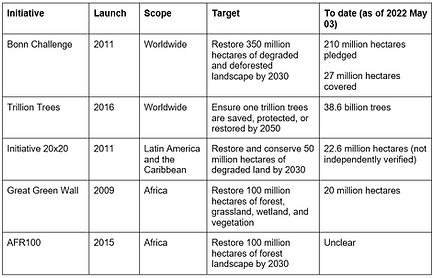
Although these large-scale programs are a strong signal of interest in tree planting and may suggest a lack of neglectedness, we cannot assume that these pledges will succeed. For example, some countries have made unrealistic commitments to the Bonn Challenge (Fagan et al., 2020). Six of the 62 countries committed to the Bonn Challenge have pledged to restore almost 50 percent or more of their land; Rwanda and Burundi promised to restore over 75 percent of their land. These countries are unlikely to succeed unless they transform their agricultural systems to use less land.
B.2.2.2 Philanthropic spending on tree planting
ClimateWorks reports that foundations spent $50M between 2015 and 2020 on carbon dioxide removal, including reforestation and afforestation efforts (Desanlis et al., 2021). However, we do not know how much of this was on trees specifically. Spending on reforestation and afforestation seems to have increased in recent years. For example, the Bezos Earth Fund has pledged to spend $1B on tree planting and restoration initiatives (Calma, 2021).
Appendix C: Improved forest management, fire management, and agroforestry
C.1 Improved forest management
C.1.1 Tractability
Studies have found that IFM may have mixed effects on emissions. For example, some researchers have concluded that the amount of forest carbon that is lost from tree harvesting could exceed the combined (1) amount of carbon that is stored in the harvested wood products and (2) amount of emissions avoided by using wood instead of other fuels (Seppälä et al., 2019; Soimakallio et al., 2016). Meanwhile, other studies have indicated that increased investments in forest management can increase both carbon stocks and the amount of wood (Cowie et al., 2021; Schulze et al., 2020). IFM also faces logistical challenges related to developing a skilled labor force, and there is a risk of leakage.
C.1.2 Neglectedness
Improved forest management overlaps with international development. Indeed, UN FAO provides countries with policy advice, technical support, and capacity-building related to sustainable forestry. However, it is unclear how much money UN FAO invests into improved forest management.
Rainforest Alliance is a major organization whose activities include training people to harvest trees sustainably. Its total revenue in 2020 was about $52M (Rainforest Alliance Inc., 2021). This money was not limited to just improved forest management.
C.2 Fire management
C.2.1 Tractability
The degree to which prescribed fires are beneficial depends on how much carbon the prescribed fire emits and how much carbon loss it helps avoid by reducing subsequent uncontrolled fires (Bowman et al., 2021). Currently, the impacts of prescribed fires in forests on carbon emissions are inconclusive (Nabuurs et al., 2022). However, the effects of prescribed fires on savannahs and grasslands are generally positive.
Fire management practices such as controlled burns face challenges from residents and bureaucratic hurdles. It also needs sufficient resources and labor and requires location-specific research.
C.2.2 Neglectedness
The Nature Conservancy is one of the largest organizations working on fire issues. Its revenue in 2019 was almost $1B, but it did not spend all of this on fire management (Nature Conservancy, 2020). There have been grassroots efforts in the US that advocate for improved fire management, such as Prescribed Burns Associations (PBAs). However, it is unclear how many PBAs there are and whether they are well-funded.
C.3 Agroforestry
C.3.1 Tractability
The IPCC notes several contextual factors that help determine the success of agroforestry projects: “water availability, soil fertility, seed and germplasm access, land policies and tenure systems affecting farmer agency, access to credit, and information regarding the optimum species for a given location” (Nabuurs et al., 2022). Additionally, farmers are probably more willing to participate when they have access to developed markets for agroforestry products.
C.3.2 Neglectedness
Agroforestry receives funding from organizations and governments working on international development. For example, the UN FAO works on agroforestry because it can help address issues related to food security in low-income countries (FAO, 2022), and BMGF has previously funded agroforestry efforts (Bill & Melinda Gates Foundation, 2022). World Agroforestry, an international nongovernmental organization, is one of the largest groups working on agroforestry. Its revenue in 2020 was $45M (World Agroforestry, 2020).
Appendix D: Spending on forestry interventions
This list of philanthropic spending on forestry interventions is not comprehensive and is intended to give a sense of where donors direct their money. For more information, please see our Google Spreadsheet.
Table 4: Philanthropic spending on interventions
We summarize the annual revenues of various organizations working on forestry interventions in Table 5. Some of these organizations work in multiple areas, so the listed annual revenue may not match how much they spend on that particular intervention.
Table 5: Budgets of example organizations
Appendix E: Co-benefits
E.1 Reducing deforestation and forest degradation
Conservation-based efforts tend to preserve biodiversity and ecosystem services more effectively and inexpensively than planting new trees. However, some measures to reduce deforestation and forest degradation can cause harm. For example, PAs have historically taken land away from Indigenous peoples and other people who depend on the forest and its resources. There have also been human rights violations related to conservation, such as violence and death at the hands of park rangers (Baker, 2019). Efforts to reduce deforestation and forest degradation also reduce the land available for agricultural land expansion, affecting food access. Finally, some initiatives could increase people’s dependence on insecure external funding (Nabuurs et al., 2022).
E.2 Afforestation, reforestation, and forest ecosystem restoration
When implemented well, tree planting projects can benefit the environment and people. For example, tree planting enhances biodiversity and provides people with renewable resources, income, and livelihoods. It may also address land degradation and desertification issues because tree roots can help reduce runoff and erosion. Forests also help regulate the water cycle and help with climate change adaptation (Ellison et al., 2017; Locatelli et al., 2015). However, tree planting can have adverse effects under some circumstances. For example, planting non-native species and monocultures can adversely affect biodiversity and the local ecosystem.
E.3 Improved forest management
Some IFM practices can improve biodiversity and water quality. For example, increased tree diversity could support a greater variety of organisms, and increased time between harvests could reduce erosion. However, strategies that solely focus on increasing biomass stock, such as tree plantations, can negatively impact biodiversity.
E.4 Fire management
Controlled burns reduce air pollution relative to what we would expect from larger, uncontrolled fires. Additionally, eliminating the dead brush through controlled burns could increase biodiversity by inhibiting the growth of certain species while also increasing nutrients in the soil (Hurteau & Brooks, 2011). Also, when fire management prevents burns from spreading to inhabited or cultivated areas, it benefits people who would otherwise be displaced or have their livelihoods affected by the fires.
E.5 Agroforestry
Co-benefits of agroforestry include potentially improved biodiversity, reduced erosion, and increased land productivity. In addition, the trees could help diversify the farmers’ livelihoods if they provide fruit or timber for harvesting. However, agroforestry could reduce biodiversity if farmers plant trees as a monoculture.
Support Our Work
Giving Green Fund
One fund. Global impact. One hundred percent of your gift supports a portfolio of high-impact climate organizations, vetted by our research.
Best for:
Donors who want the simplest way to impact multiple climate solutions.
Top Climate Nonprofits
Meet the organizations on Giving Green’s list of high-impact nonprofits working to decarbonize our future, identified through our rigorous research.
Best for:
Donors who want to give directly and independently.
Support Our Work
We thoroughly research climate initiatives so you can give with confidence. For every $1 we receive, our work unlocks another $21 for effective climate solutions.
Best for:
Donors who want to amplify their impact through research.



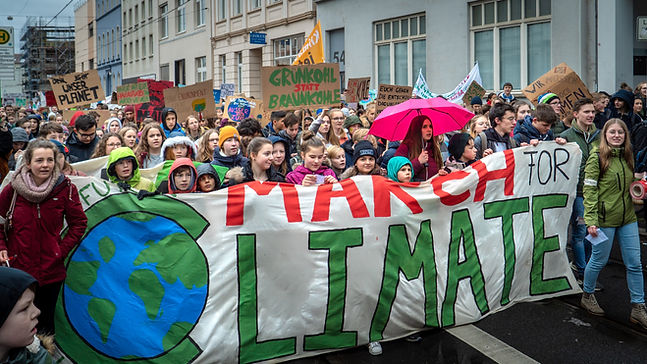





.png)
.png)


.png)

.png)
.png)




.png)

.png)


.png)

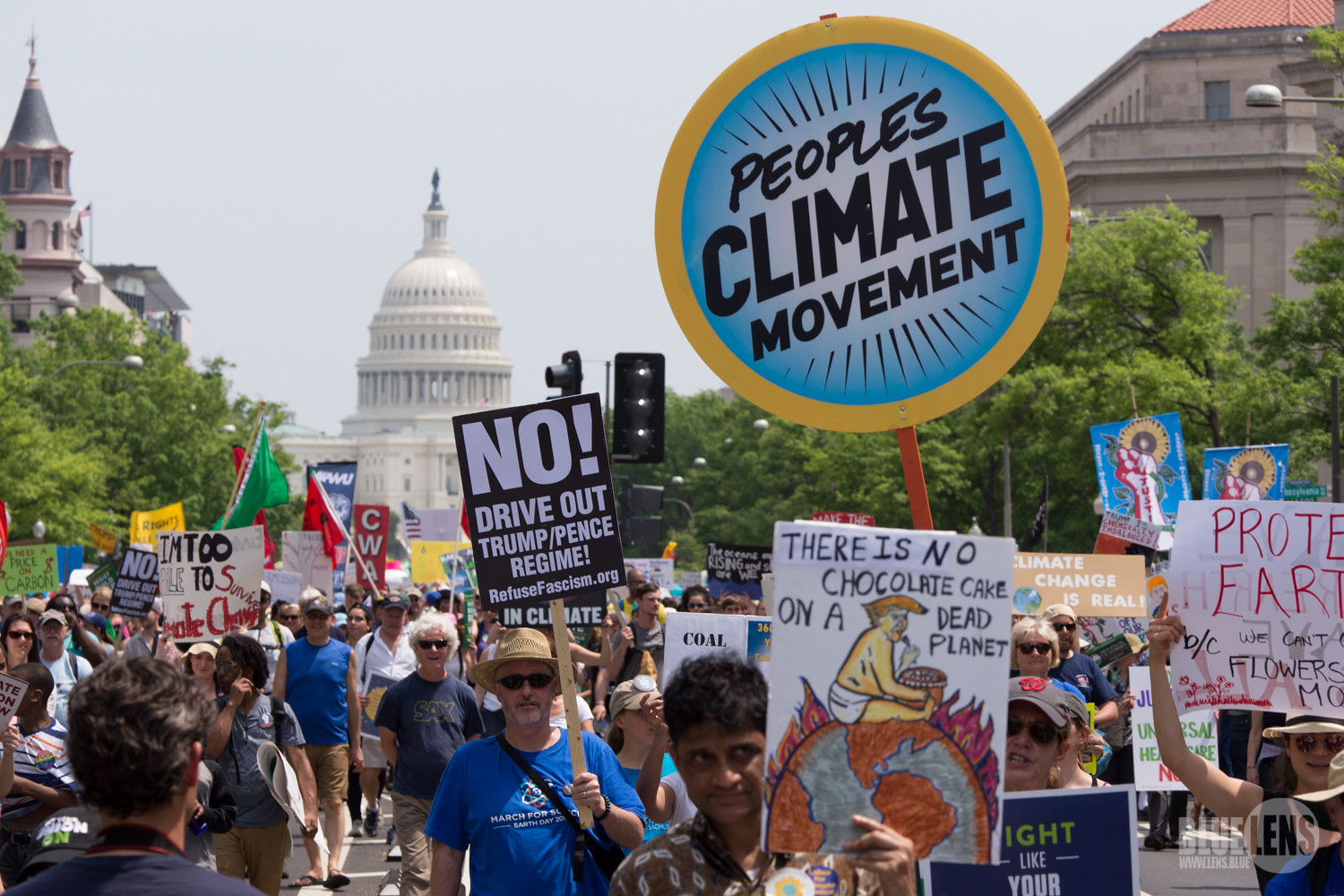
.png)


.png)
.png)

.png)

.png)
.png)

.png)




.png)

.jpg)



.png)
.png)
.png)

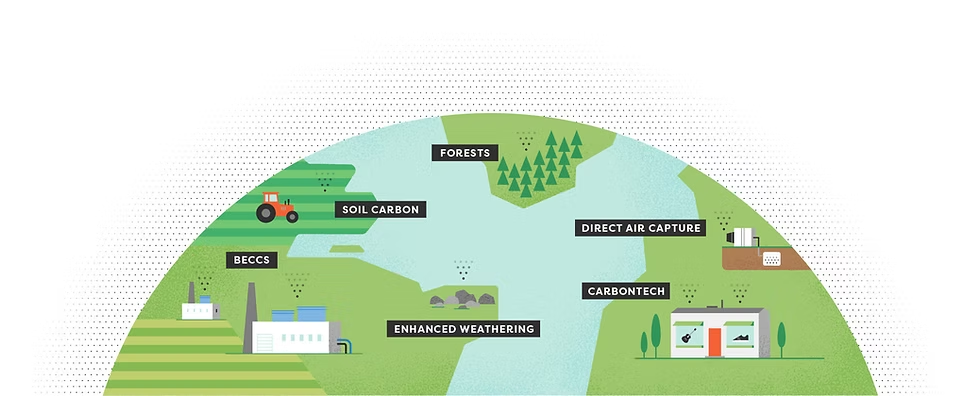

.png)
.png)
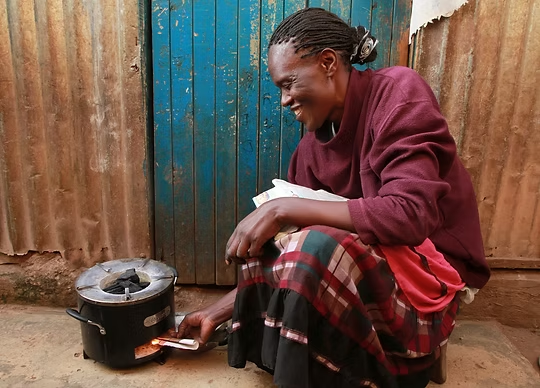


.png)





.png)

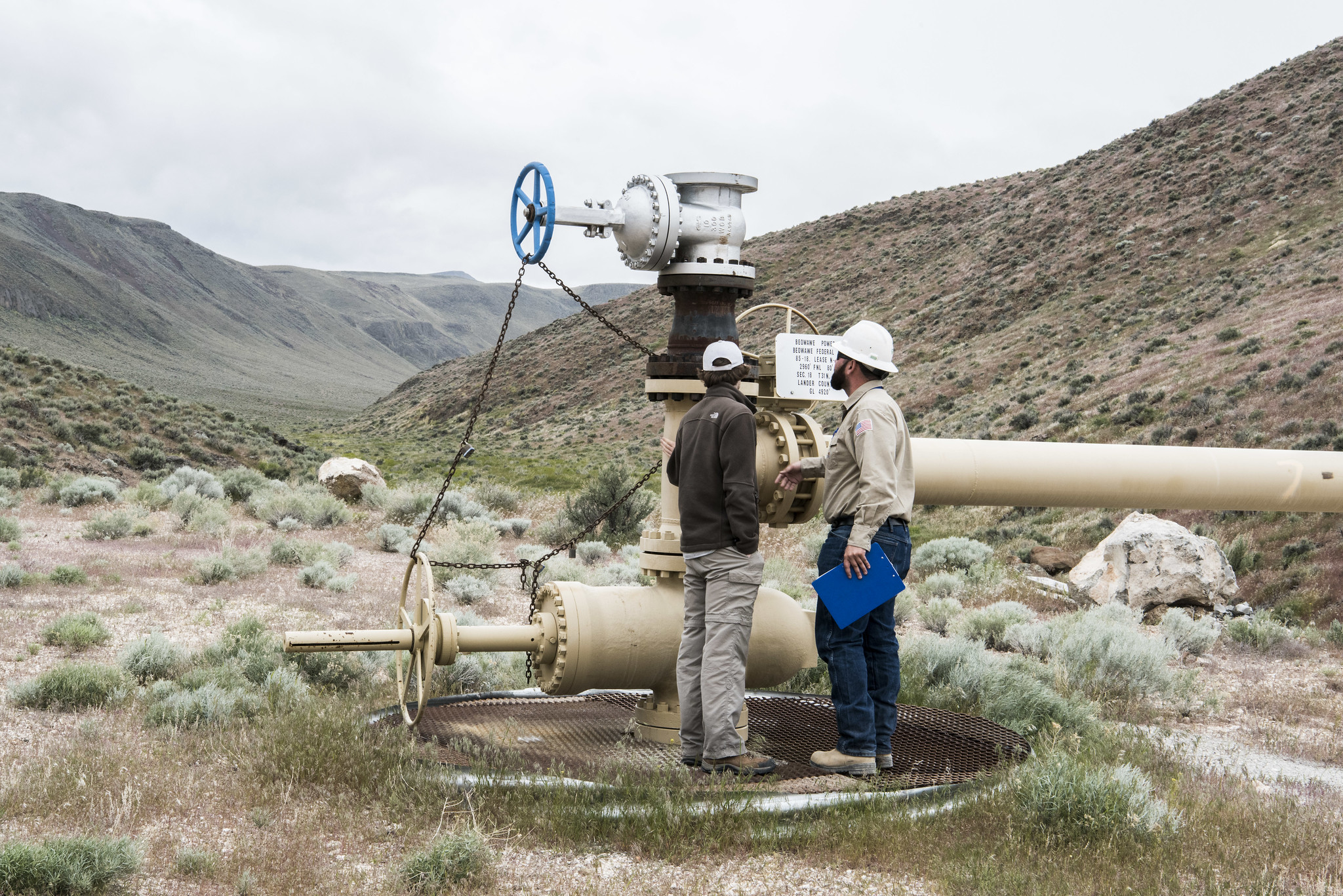
.png)
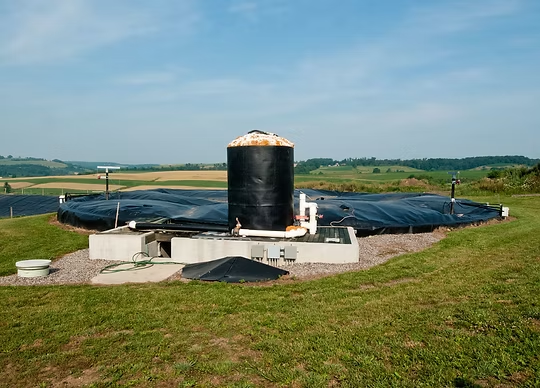



.png)

.png)
.png)
.png)



.png)
.png)

